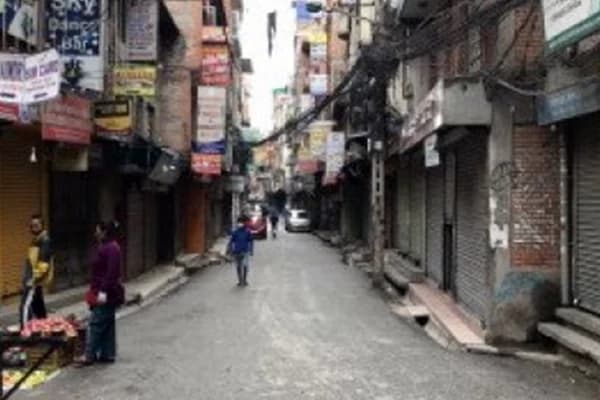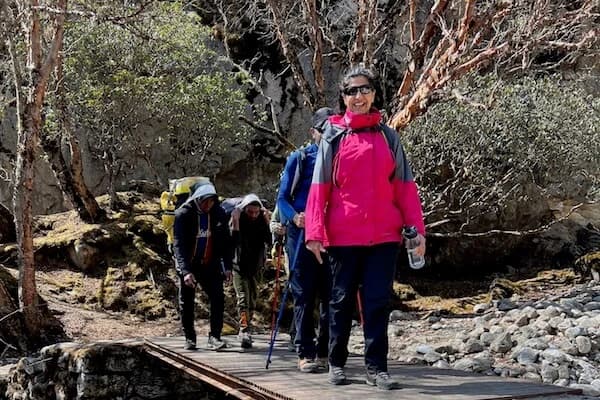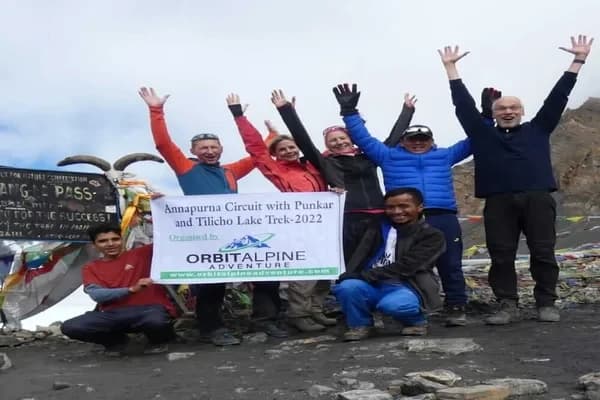COVID-19 and Nepal
Nepal shares its 1,414 kilometers northern border with the Tibetan Autonomous Region. Hundreds of Nepalese students go to China for abroad study every year. Talking about the distance between Wuhan and Nepal, it is around 2,921 kilometers where you can travel by using for modes of transportation. You can fly from Kathmandu to Wuhan directly. Moreover, you can use train, bus or car to drive along the land way as per the convenience and availability.
Even after the outbreak of COVID-19, the Government of Nepal rescued 175 Nepalese citizens via Nepal Airlines Airbus A330-200 plane. Brought on February 16 2020, 170 of them were students and 5 other professionals. After bringing here in the nation, they were kept in quarantine for 14 days to confirm the infection of this epidemic at Kharipati, Bhaktapur.
Despite the close proximity of geographical location, Nepal is one of the least affected countries in the world by this easily transferrable virus. Ever since the beginning of this pandemic, thousands of Chinese tourists have visited Nepal and returned to their country. But also, according to the data released on March 4 by the authority, there are only 9 cases of COVID-19 in Nepal in which 1 infected Nepalese has already recovered and other patients are in normal condition.
The Government of Nepal announced the nationwide lockdown on 24 March to minimize the possible spread of novel coronavirus throughout the nation. Although WHO warned the alarming situation of Nepal due to this pandemic, there are a handful of the corona infected cases. The concerned authority declared the ban on public ceremonies, shopping malls, cinemas, schools, colleges and universities. This prompt of the government has given a little compensation to the countrymen.
Impacts of COVID-19 in Nepal:
Tthe entire world, especially the most aggravated nations, has gone through full or partial lockdown as the safety measure to put the infection of COVID-19 under control. This epidemic has had impacts on different sectors from industry to daily activities of the people throughout the world. In this context, Nepal can’t be an exception. There are more bad impacts while some good impacts in Nepal. The impacts of this worldwide crisis in Nepal can be listed as below:
Economic Impacts
As soon as the whole country went into lockdown, most of the industries are closed. In case such industries are open, the large number of employees gather into the industry premises that the novel coronavirus infection can transfer from one to many. Although there is not much cases of such pandemic, the government took the necessary steps not to slip the controlling situation beyond its approach.
When the productions are not made, there won’t be anything to export from the country. Low or no quantity of export means trade deficit that it always causes adverse effects in the national economy. Similarly, small enterprises are also badly affected as they cannot provide goods and services to the customers, who are the only source of their income.
The lockdown has imposed the loss of employment that results in the lack of economic strength of the people. When a large number of people stay jobless, they cannot generate income to meet their everyday expenses. Apart from this, the citizens are busy in storing the daily necessities in their houses to avoid the shortage for a comparatively longer period. The shortage of goods and services in the market creates price hikes in the long term.
Socio-cultural Impacts
COVID-19 has put a lasting impact on socio-cultural aspects of the society. As the ceremonies are banned, people can’t gather in larger than the specified number by the government. And gathering in the larger number is always threatening for the communication of this pandemic. Most of the celebrations of Nepal are made in the large number of people gathering into a single venue.
The government has provisioned to strictly penalize the organizer of such ceremonies if they don’t abide by the rules and regulations. In the context of Nepal, even while funeral ceremonies, more than 7 people are not allowed to participate in funeral procession. In the urban areas, this rule may not be much problematic as there are vehicles to transport the corpse up to the crematory. But in the rural parts, people have to carry the dead body on shoulders up to the cemetery site. In this way, this has been a significant impact of COVID-19 in their socio-cultural aspects.
Even while harvesting time, there is the barter system in many parts of the nation. For this purpose as well, the people have to gather into a limited space. Gathering into a single place means that there is always chance for coronovirus infection to communicate from one person to many others. The number of people gathering into a specified space totaling to 21 has disturbed the people to observe the socio-cultural practices in an usual flow.
Impacts on Education
The lockdown has caused a serious impact on education of the children. The schools, colleges and universities have been closed since March 18 2020 (Chaitra 5th). For this purpose, the scheduled examinations of the school level was reshuffled and was instructed to have completed by March 17 2020. The examinations’ date was changed to minimize the possible spread of this infectious disease.
The School Education Examination (SEE) was scheduled to start from 19th March 2020 (Chaitra 6th). However, the threat of the communication of COVID-19 compelled the government to postpone the examination. Now, the government has declared to reschedule this examination immediately after the termination of the lockdown.
Similarly, the examinations of National Examination Board (NEB) and universities are also put off due to the unavoidable circumstances. This sudden change in the routine of the final examination has caused a serious impact on the psychology of the students. Especially, the children of school levels are compelled to spend the time most monotonously.
As most of the parents are not well educated, they don’t know how to help their children to spend the lockdown constructively. Even if they know, their resources may not be available or enough to make the leisure fruitful. Although the college and university students can spend the time by doing recreational activities, it is too hard for the children.
Environmental Impacts
Although there are adverse effects on other aspects of the society, there are positive impacts on environment. The nationwide lockdown has put a ban on public transportation and running of the factories. The environment of the urban areas gets polluted due to the emission of the harmful chemicals like CFCs released by the vehicles and factories. Likewise, the byproducts of the chemical factories are directly or indirectly mixed into the water resources.
The CFCs are the major pollutants of the natural environment as they get mixed into the atmosphere. When the atmosphere is polluted, there are many diseases seen in the population. Different types of pollution like soil, air, water and noise are the result of the harmful gases emitted by these vehicles and factories. Besides, the environment of the rural areas is pollution free due to the presence of the forests and lack of CFCs.
Due to the halt of public transportation and factories, the environment looks really neat and clean. The latest data on environmental pollution released by different organizations related to the environment shows that the ozone layer depletion also has come too low. The hole of the ozone layer is decreasing day by day that there is hope for a better environment worthy of living. The neat and clean environment means the favourable situation for conservation of biodiversity.
Impacts on Tourism
As Nepal is a Himalayan nation having 8 out of the 14 mountains above 8,000m. Fast flowing rivers, high altitude villages, dense forests and diverse wildlife are other resources of Nepal. Despite a small country, all types of major climate are found here. The tropical forests to alpine vegetation is the habitat for a large varieties of animals and birds. One-horned rhino, Royal Bengal tiger, snow leopard and other many endangered species of animals attract millions of tourists every year.
Moreover, Nepal is a multi-cultural, multi-ethnic and multi-lingual country located in South Asia. The diversity of ethnicity has resulted into the availability of diverse social spectrum. The feasts and festivals plus customs and costumes are other unique experience one gets ever in their life. The most alluring aspect of Nepalese society is that there is more festivals than the number of days in a year!
More than this, Nepal is the birthplace of the Lord Buddha, the “Messenger of the World Peace.” The Buddhist shrines are built from Terai to Mountain regions. Lumbini is a must-visit place in Nepal. You have many places like Maya Devi temple, Ashokan pillar, Myanmar Golden Temple, World Peace Pagoda, Dharma swami Maharaja Buddha Vihar, China temple and Lumbini Museum. Visiting these sites gives you the real sense of peace of the mind and the soul.
These natural and cultural aspects have been boon for the Nepalese tourism. Millions of tourists from all over the world come to Nepal for visiting different Himalayan regions, city areas and protected areas. Nepal has been the Number 1 Tourist Destination in the world. After the sudden intervention of COVID-19, the international tourists are banned to visit Nepal due to the lockdown. The flights are banned and the open border with India is also strictly blocked.
More than this, the Government of Nepal had announced to celebrate this year as Visit Nepal 2020 since 2018. The concerned authority had made necessary preparations to make this tourism festival a grand success. Many promotional campaigns were conducted in Europe, America and other parts of the world. The publicity of Nepalese tourism in the international tourism market had drawn the attention of the world towards Nepal.
Along with the maintenance of the existing tourism destinations, the Nepal Tourism Board introduced hundreds of new touristic destinations to promote the tourism. It was targeted to bring more than 2 million international tourists in Nepal in Visit Nepal Year 2020. Besides tourism and trekking, adventurous tourism and community-based tourism was aggressively advertised to catch the sight of the international community. The Visit Nepal 2020 Promotion Committee had already nominated the brand ambassadors from in and out of the country.
Sudden outbreak of COVID-19 hit the ambitious tourism campaign of Nepal government. Many tour and trekking packages booked in advance were cancelled at the eleventh hour. Cancellation of trips created the confusions in the Nepalese tourism market. The agencies involved in tourism industries couldn’t exactly decide what to do next. Tourism is the most reliable source of the employment opportunities and revenues of the Nepal government.
This alarming situation hampered the tourism market and industries associated with this including the government revenues. Trekking and tour guides, entrepreneurs plus food and accommodation sector are highly influenced by the pandemic situation. The hotels and lodges of the nation including the prime trekking regions are almost shut due to the lack of the travellers.
However, the government of Nepal and the agencies involved in tourism industries tried their best to provide safety to the international travelers. More than 1000 foreign travellers stuck in the high Himalayan regions of the country were rescued by the tourism industries in coordination with the government. Those tourists who are in short of money are provided with the food and accommodation facilities by such agencies.
More than business, the tourism agencies and the Nepal government gave top priority to the spirit of humanity. Those tourists stuck in Nepal and want to return their home country have been facilitated to reach their home countries via the chartered flights. Despite the poor preparation and facilities of Nepal, the international tourists are helped at the fullest. It further justifies the ethics of Nepalese society that “Guests are Gods!”
As the expansion of COVID-19 and its impacts are unpredictable, the government of Nepal has put a ban on international flights till April 17 2020. This ban is imposed on the compulsory circumstances. One must be flexible to understand this hard time which has badly affected the entire world including the most developed and riches nations. Though late, the prompt action of the government of Nepal has been really helpful to keep the infection and spread of novel coronavirus under control.
Why Nepal is still safe from COVID-19?
On the account that there have been only 9 cases confirmed to the date, Nepal is still safe and far from the haunt of COVID-19. The intellectuals and experts of medical sciences from all around the world opine that it is the food habit and socio-cultural practices of Nepalese people responsible for putting this epidemic still far away. The Nepalese people eat spicy food stuffs and cooked at higher than 100º C that it kills all types of harmful viruses.
Next, the Nepalese people greet one another by joining hands rather than hugging and handshaking. This is another reason behind the less intervention of nCoV2 in the Nepalese society. The researches conducted until today have confirmed that this virus transfers from one person to others via direct physical contact. It enters into our body through the mouth, eyes and nose if we touch these parts with the infected hands.
Similarly, traditionally Nepalese always maintain the proposed 1-meter-distance that is safe from the communication of novel coronavirus.
Another possible reason for not being much infected by this deadly virus is that we eat the fruits and vegetables grown up by using organic fertilizers rather than chemical ones. The organic food items always keep our immunity stronger to fight back with the viruses of this kind. Similarly, the population density is another responsible factor for remaining away from this disease. Except some urban areas like Kathmandu, Pokhara, Biratnagar, etc., the population density of Nepal is really sparse. When there is scarce population, there is less chance for communication of such diseases.
The last but not the least, the growing literacy rate has played the most significant role in less infections in the Nepalese. Regardless some exceptional cases, the Nepalese have been following the campaign “#stay home; stay safe!” The national level and local organizations are actively involved in creating awareness amongst the people. They are spraying the disinfectants in the public places and distributing sanitizers to the people.
Future Prospects of Nepalese Tourism
As soon as the lockdown is over and the nation is confirmed safe from COVID-19, there is high potentiality of tourism in Nepal. Toursts will be able to Travel Nepal again and focus on the Must do treks in Nepal once in a lifetime. The lack of CFCs in the atmosphere has purified the air that is beneficial for health. Lack of smoke and fumes in the air has increased the visibility in Nepal as well. The environmental cleanliness will be fruitful to have the 360-degree panoramic view of the snowcapped peaks, lush valleys and green forests.
Similarly, the number of flora and fauna will also increase as there is no intervention of humankinds in the natural environment. Most of the local governments have given priority to conserve the socio-cultural assets of the respective region in this time. The lifestyle, culture and tradition of the Nepalese people will be another most interesting factor you want to learn. More importantly, there will also be a good scheme to promote tourism in Nepal by the tourism agencies and the government.
Conclusion:
COVID-19 has been a common threat to the entire world. The impacts of this virus can be minimized or stopped although it is rapidly expanding every day. By bringing the change in our food habit and socio-cultural practices, we can fight back this epidemic. First of all, we should maintain social distancing and covering our mouth while sneezing or coughing can also prevent the spread of this virus.
Similarly, we should follow the campaign “#stay home; stay safe!” and wash our hands with sanitizers or soap water every now and then. We should always have the food items that restore the immunity to the best of its form. If one takes the necessary precautions and maintains personal hygiene, they can remain safe from this epidemic. As soon as you see any of the symptoms specified by WHO and the experts, you need to go to health institutions for check up. Finally, you must keep yourself in quarantine and isolation if you find such symptoms.
Although you cannot visit Nepal right now, you should be patient about this because this is not the problem of Nepal only. The entire global community is infected more or less with this epidemic. As soon as the situation comes under control and the travel industry becomes safe, you can contact us. We are always committed to provide you the best tour and trekking package in Nepal, Tibet and Bhutan respectively.





